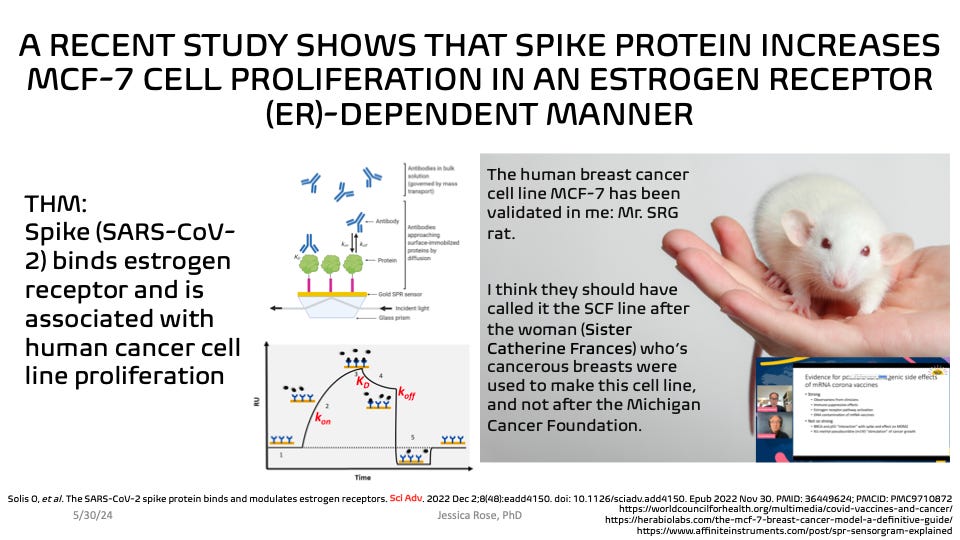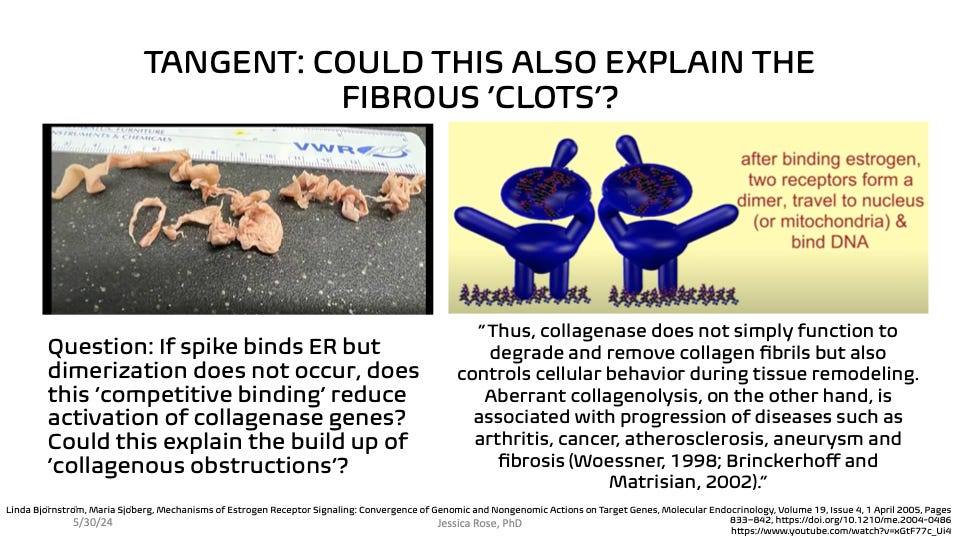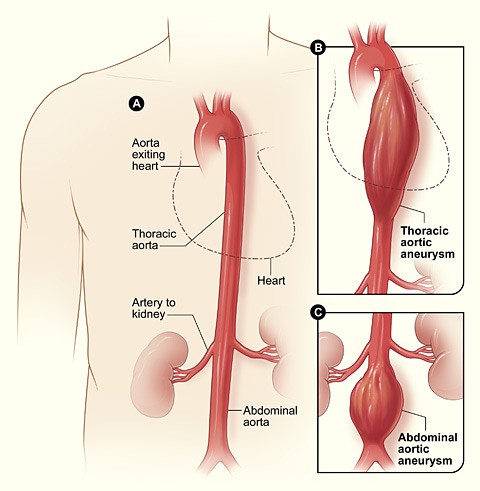Spike binds estrogen receptor and could alter collagenase gene expression
An investigation of a recent publication
A paper entitled “The SARS-CoV-2 spike protein binds and modulates estrogen receptors” was published in December 2022 that describes a study that demonstrates that the SARS-spike protein binds and modulates estrogen receptors. It also demonstrates that the spike protein increases proliferation of a breast cancer cell line in an estrogen receptor-dependent manner and this begs many questions about the effects of the COVID-19 shots on individuals who are susceptible to, or fighting, breast cancer.
This paper’s results are stunning (by the way, thank you to Maarten Fornerod for bringing it to my attention), and it begs a very important question: since the SARS-2 spike binds estrogen receptors, then does the injection-produced spike also bind them and if so, what are the downstream effects pertaining to ‘normal’ gene activation?
Here’s what you need to know. Estrogen receptors (ERs) are proteins found in cells and are activated by the hormone estrogen (17β-estradiol). They are responsible for activating specific genes (DNA transcription factors) related to cell proliferation and differentiation, hormone regulation, bone and cardiovascular health, brain function and cancer prevention. Estrogen receptors come in two classes: ERα and ERβ, and are found in the endometrium, breast cancer cells, ovarian stromal cells and the hypothalamus in the case of the former, and in ovarian granulosa cells, kidney, brain, bone, heart, lungs, intestinal mucosa, prostate, and endothelial cells in the case of the latter.They can also be membrane-associated.
ERs also have additional functions independent of DNA binding. ERs can also regulate gene expression via protein-protein interactions with other nuclear DNA-binding transcription factors. ERs can also be membrane-associated, as mentioned, and can subsequently alter cytoplasmic protein function both in the cytoplasm, and in those related to gene expression in the nucleus.
Estradiol is a hormone derived from cholesterol, and is produced primarily in the ovaries of females, but can also be produced in the adrenals, the liver, brain, fat, breasts and testes of males. It traffics to various cells throughout the body to effect its function. Following diffusion across cell membranes, it binds with high affinity to cytosolic ERs inducing a conformational change in the ER (don’t confuse this with the endoplasmic reticulum!). This conformational change allows for dimerization (pairing) of ERs bound to their cognate estradiols. This estradiol-dimer complex then translocates to the nucleus to bind response elements known as estrogen response elements (EREs) located in the promoters of target genes. This regulates the activity of different genes. Please watch this video for some nice visualizations of this pathway to gene activation.
Of the genes activated by the 17β-estradiol-ER-dimer complex, is a gene called collagenase.
Several genes are activated by 17β-estradiol through the interaction of ERs with Fos and Jun proteins at AP-1 binding sites. Such genes include those for ovalbumin (7), IGF-I (8), collagenase (9), and cyclin D1 (10, 11).
Collagenase is an enzyme that breaks up native collagen fibrils in connective tissue and is very important in wound healing: it allows healthy tissue to grow by breaking down collagen. It is produced as part of normal immune responses. Think of collagenase like your very own meat tenderizer. Mutations in collagenase genes are associated connective tissue diseases, Osteogenesis imperfecta (brittle bones), Spondyloepiphyseal dysplasia (defective development of spine/skeleton and joints) and other collagen vascular diseases (autoimmune) including lupus, rheumatoid arthritis, and aortic aneurysms.
This leads me to an hypothesis pertaining to spike binding ERs.
My hypothesis is this (in the context of the modified mRNA-LNP products):
Since targeted delivery of the modified-spike-mRNA-LNP complex results in massive amounts of (intracellular) spike protein production, and spike protein binds to estrogen receptors, is it possible that this binding event prevents dimerization of ERs to subsequently down-regulate specific gene activity? And if so, is one of these genes collagenase? And if so, is this why we are seeing strange de novo connective tissue disorders and fibrosis in individuals post COVID-19 injection?
There are 361 reports in VAERS in the context of the COVID-19 shots for ‘Aortic aneurism’ (AA) whereby 24% of these people died, and thousands for aortic malfunction and aneurisms, just as one example of an emergent signal. When comparing the AA signal to all vaccines combined for 2018-2020, there are 69 times more reports made in the context of the COVID-19 injections for 2021-2023.
To be continued…
Solis O, Beccari AR, Iaconis D, Talarico C, Ruiz-Bedoya CA, Nwachukwu JC, Cimini A, Castelli V, Bertini R, Montopoli M, Cocetta V, Borocci S, Prandi IG, Flavahan K, Bahr M, Napiorkowski A, Chillemi G, Ooka M, Yang X, Zhang S, Xia M, Zheng W, Bonaventura J, Pomper MG, Hooper JE, Morales M, Rosenberg AZ, Nettles KW, Jain SK, Allegretti M, Michaelides M. The SARS-CoV-2 spike protein binds and modulates estrogen receptors. Sci Adv. 2022 Dec 2;8(48):eadd4150. doi: 10.1126/sciadv.add4150. Epub 2022 Nov 30. PMID: 36449624; PMCID: PMC9710872.
Dahlman-Wright K, Cavailles V, Fuqua SA, Jordan VC, Katzenellenbogen JA, Korach KS, et al. (Dec 2006). "International Union of Pharmacology. LXIV. Estrogen receptors". Pharmacological Reviews. 58 (4): 773–81. doi:10.1124/pr.58.4.8
https://en.wikipedia.org/wiki/Estrogen_receptor#cite_note-pmid15705661-2
Levin ER (Aug 2005). "Integration of the extranuclear and nuclear actions of estrogen". Molecular Endocrinology. 19 (8): 1951–9. doi:10.1210/me.2004-0390
Linda Björnström, Maria Sjöberg, Mechanisms of Estrogen Receptor Signaling: Convergence of Genomic and Nongenomic Actions on Target Genes, Molecular Endocrinology, Volume 19, Issue 4, 1 April 2005, Pages 833–842, https://doi.org/10.1210/me.2004-0486
https://medlineplus.gov/ency/article/001223.htm





No comments:
Post a Comment